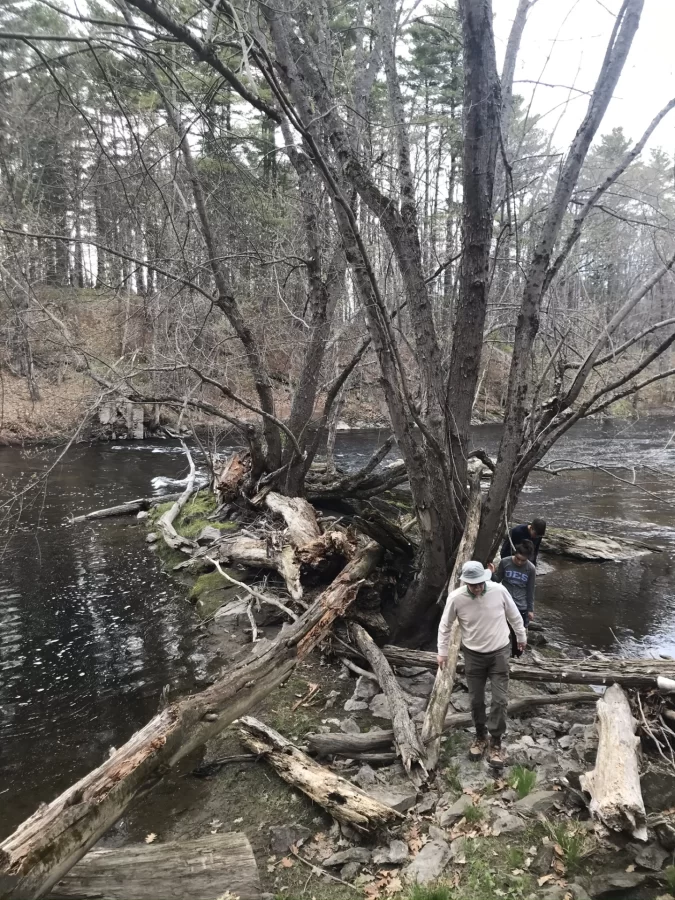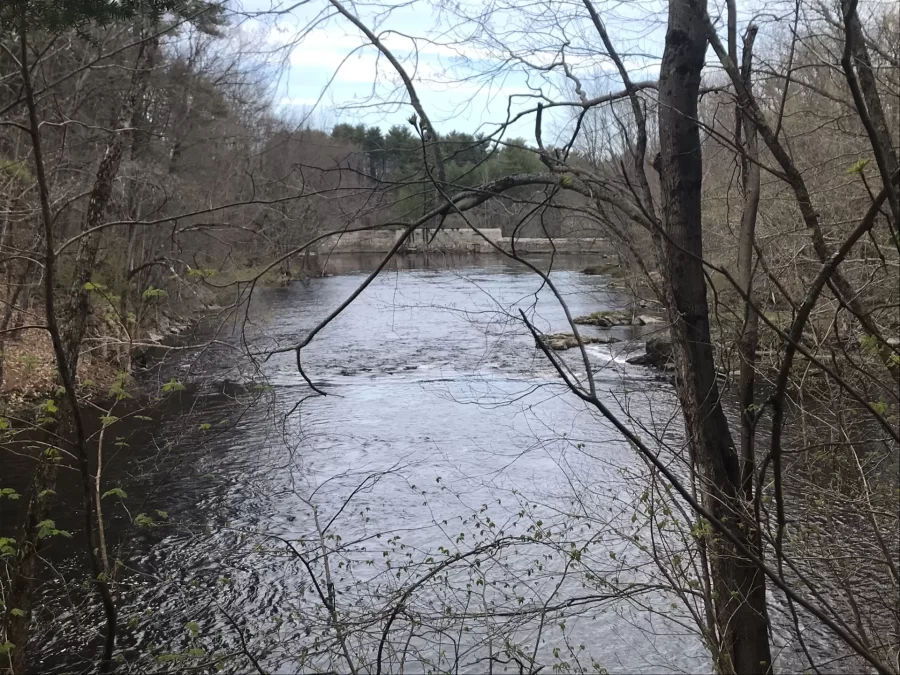A River Runs Through It
The spring is in full swing in Lewiston, Maine, and as friends and family come to Bates from around the world to celebrate the accomplishments of seniors and reunite with old friends, it’s a perfect time to go out on a scenic walk to appreciate the natural beauty our area offers. One favorite local spot is the Lewiston Riverwalk, a paved trail that runs along the Androscoggin River, just a few minutes’ walk from campus. It’s a great place for a bike ride or run, a leisurely stroll to watch warblers, ducks, and other wildlife, or to fish for some of the trophy smallmouth bass that lurk in the impoundment above Lewiston Falls dam.
Not so long ago, the idea of taking a scenic walk along the Androscoggin River through Lewiston would have seemed almost unimaginable. Once known as one of the dirtiest rivers in the United States, the Androscoggin suffered from decades of contamination from paper and textile mills along its banks. During the drier summer months, low flows in the river allowed foam to accumulate on the surface, and unpleasant odors loomed over the town. Dissolved oxygen counts dwindled, severely curtailing populations of fish and macroinvertebrates in the riverine ecosystem. As the situation continued to deteriorate in the mid-twentieth century, local residents and business owners began advocating for regulations on industrial discharges of pollutants. Building on years of grassroots advocacy and a deep personal commitment to improving conditions in the Androscoggin, Rumford native and Bates alum Senator Edmund Muskie ‘36, spearheaded the passage of the Clean Water Act in 1972. With further advocacy from local advocates such as Bates alum Peter Rubins ‘72 and Maine State Senator John Nutting, new state laws imposed further regulations that limited use of dioxins while implementing rigorous control over color, odor, and foam pollutants.
This year marks the 50th Anniversary of the Clean Water Act. The milestone provides an opportunity to celebrate the progress that has been made and serves as a reminder that dedicated advocacy and policy change can lead to positive, measurable impacts for the environment. I had the pleasure of working closely with two Bates student groups this spring who used their research skills to support local municipal officials and community groups in their efforts to make continued improvements to the health of the Androscoggin watershed and the ecosystems that depend on the river.
One pair of students from the Community-Engaged Research in Environmental Studies course, Quinn Kieselowsky and Robby Griffin, partnered with the Lewiston-Auburn Community Forest Board (LAFCB) to identify clusters of invasive species in the area and develop management strategies to limit their spread and impact. Two such species – Oriental Bittersweet and Japanese Knotweed – can be found in abundance along the Androscoggin Riverwalk. Left unchecked, knotweed spreads so voraciously that it eliminates habitat for native plants that provide important food and habitat for pollinators and other wildlife. Thick, bittersweet vines can be found climbing tall oaks and silver maples along the banks of the Riverwalk; if they are not cut, those vines will eventually choke and kill the trees, which can turn them into hazards and increase runoff. Working with Lewiston City Arborist Steve Murch, Quinn and Robby mapped out some of the key problem areas on the Riverwalk. Their research will be used to guide removal efforts by Steve’s team and community volunteers in the coming month. The students’ research also provided a road map of options for keeping invasive species at bay in the long-run.
On the Auburn side of the river, Isaac Levinger and Rachel Lowell worked with the Auburn Conservation Commission to explore improvements to fish passage and overall ecosystem health in the Little Androscoggin, a major tributary. Most of their efforts focused on supporting the removal of the breached and defunct Littlefield Dam, a 250-foot stone dam that serves as another barrier to the passage of keystone species such as alewives, which serve as an important food source for the endangered Atlantic Salmon; both species historically provided a staple in the diet of indigenous people in this area, but they have been blocked from traveling upstream to spawn by multiple dams downriver. Isaac and Rachel’s research focused on the history and construction of the Littlefield dam and the various impacts of dam removal. Over the course of the three and a half week Short Term, they connected with libraries around the state and went on multiple site visits to meet with stakeholders such as homeowners and manufacturing facilities downstream from the Littlefield dam.They also researched the ways that dam removals can impact ecosystems, local landowners, and recreational opportunities. Their efforts made an important contribution to the Conservation Commission’s preparation for an upcoming grant proposal to NOAA to fund fish passage improvements.
Much work remains to be done to restore the Androscoggin River and its tributaries, but it is deeply rewarding to see a new generation of environmental leaders develop skills, knowledge, and experience through their community engagement work at Bates. I look forward to seeing their research contribute to the ongoing efforts to restore and revitalize the Androscoggin River’s ecosystems in the months and years ahead.


